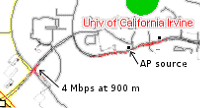|
Project:
Autonet and Wireless Testbed
PIs:Michael G. McNally, Associate Professor; R. Jayakrishnan,
Associate Professor; and Will Recker, Professor, Civil and Environmental
Engineering, UCI
Funding: National Science Foundation & Caltrans
Division: UCI
Corporate Partner: Caltrans
Start Date: June 2003
|
 |
|
Researchers at UCI are studying how pervasive computing and communications
can improve transportation management. Their approach is based on
two premises. First, microprocessor size and cost are declining,
making it cost-effective to embed a Pentium-class computer in a
car. Second, these processors can be applied to helping drivers
make better decisions and disseminating information about the transportation
system. Enter Autonet, a distributed, pervasive computing platform
linking in-vehicle and roadside computers using high-bandwidth wireless
technology.
"One goal of the Wireless Testbed is to develop a common set
of tests and benchmarks so that, as new technologies become
available, we can quickly determine their strengths and weaknesses
compared to other technologies."
- James Marca, postdoctoral researcher, Institute for Transportation
Studies, UCI |
The obvious
application of such an ad hoc mobile network among cars is to take
existing in-vehicle navigation systems the next step to use real-time
estimates and near-term predictions of travel conditions. But more
exciting for UCI researchers are the possibilities for using this
vehicle-based network to enable more distributed, system-optimal
traffic management. For example, one idea funded by NSF is a system
in which an intersection controller estimates the likely destinations
of approaching vehicles by querying each vehicle's historical record
of trips. If the destinations of a percentage of the vehicles can
be predicted, then local intersection control decisions can be made
within the context of their global impact. The vehicles become cooperating
partners in the traffic management system. By tapping into the information
storage and processing power available within each vehicle, the
traffic management authority can approach system-optimal control.
UCI traffic management specialists are also collaborating with members
of UCI's Information and Computer Science School and Caltrans to
examine capabilities of local-area wireless technologies, such as
the increasingly popular 802.11b and the new dedicated short-range
communications (DSRC) standard. This group is experimenting with
vehicle-to-vehicle and vehicle-to-roadside communication. They seek
to quantify the impact of various factors like distance, relative
speed, packet sizes, traffic volumes, etc., on the throughput of
wireless links. The researchers were encouraged by preliminary data
showing that communication is possible between a moving vehicle
and an access point (AP) at approximately 900 meters at better than
4 Mbps, using off the shelf hardware. At the same time, there are
many inefficiencies in using 802.11b in automobiles: handoff between
access points does not anticipate the movement of the vehicle; WiFi
signals degrade at relative speeds of around 100 mph (two vehicles
approaching each other at freeway speeds) due to Doppler shift of
the signal; and hills and curves block the line of sight essential
to a WiFi connection.
The researchers' overall goal is to develop high-level Autonet applications
that leverage pervasive wireless communication between vehicles.
They are cooperating with other research groups within Cal-(IT)2
to develop the wireless hardware and middleware that will make the
Autonet possible.
Contact: Will Recker, wwrecker@uci.edu,
949-824-5642
R. Jayakrishnan, rjayakri@uci.edu,
949-824-2172
Mike McNally, mmcnally@uci.edu,
949-824-8462
|

